How to Cut High Branches From Ground
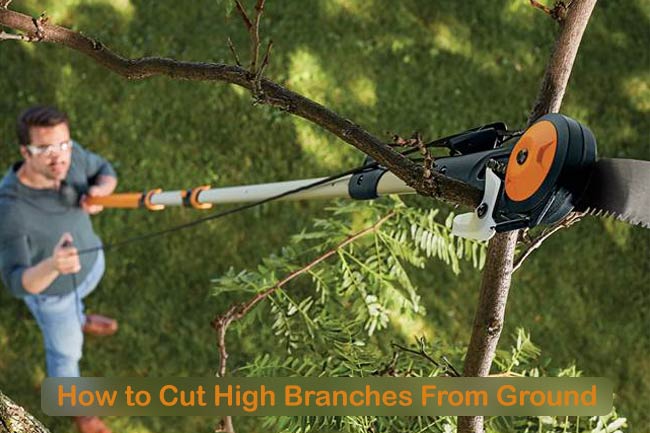
Whether to cut a dead branch, or to remove one that is causing trouble, youmay be wondering how to cut high branches from ground. There are certainly many ways to do that, but here we’re discussing 4 methods of cutting tree branches from ground.
The methods include a few tools to do the job easily without much hassle. You can use one of the methods that goes best with your situation and availability of the tool. You may need any of the tools from these four- a pole pruner, pole saw, pocket saw, or pruning saw. The additional gears you may need throughout the methods will be added to each of the methods. So, get your tools ready to start the process.
How to Cut High Branches From Ground – Depth Analysis

Using a Pole Pruner to Cut Branches with Shorter Diameter
You can cut the branches of a tree with a pole pruner just standing on the ground. A pole pruner is a handy tool to use when you don’t have the option to reach a higher branch of a tree.
Gears you may need:
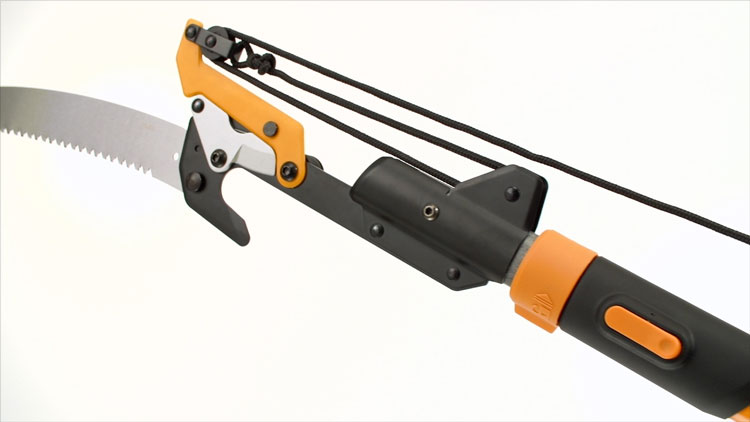
- A pole pruner is all you need!
Consider a few things-
Diameter of the branch: The diameter of the tree branch makes a huge difference when cutting with a pole pruner. It also depends on the fact that if the person who is pruning the branches has a strong grip can handle an inch of limbs. But average people may cut less than ¾ of anch of diameter at once.
Wood Type: There are a variety of woods available, some are hardwoods, while some are softwoods. Hardwoods are definitely difficult to cut, especially with a small pole pruner. But softwoods almost cut like butter even with this tiny tool.
Live Wood or Dead Wood: Live wood is easier to cut where dead wood is quite tactful to remove with a long-handled tool. So, when cutting a dead wood with a pole pruner, consider reducing the diameter to a manageable grip. And when it comes to a wider limb, cut at the smaller diameter, then move to the wider side. Cutting at a wider part in the first place might not be right if you are using the tool for the first time. Also, the pruner head might get stuck on the brunch, or worse, it might even break.
Length of the Pole: Pole pruners have various lengths. Regular ones are normally 6 to 12 feet length, but telescopic pruning tools have upto 40 feet of length. But bigger length will require more strength to handle.
Before buying one look for the length you need. Depending on your requirement, purchase the length you need. But if you already own one that doesn’t quite reach the branches, you may need to use something on the ground to reach the length.
Method

After determining the diameter of the tree branch, cut to a suitable position. Pole pruners use a leverage system or rope pulleys to cut branches. which enables you to cut it from the ground without having to reach at the top. Cut the branches closer to the collar, but do not cut the collar. Also, when cutting at the fork, cut closer to the fork of the tree limb.
A large tree branch has a wider diameter than a smaller tree banch has a relatively narrower diameter. Trimming the narrower branch would be easier with a pole pruner than a wider branch. When cutting a bigger limb, start with a smaller portion. Just give a few small strokes to cut it from the branch. Do not try to cut at once. The tool may get stuck into the branch and might ruin your tool.
Caution: The tool makes the job very easy and fast-driving, however you should be careful about some matters when cutting high branches. Predetermine the place where the branch may fall off when it is cut and as soon as the branch moves from there go to a safer place so that you don’t get hit by it.
Using a Pruning Saw with a Ladder
However, the topic is about cutting tree branches from the ground, when you don’t have other tools on the list but you have a manual pruning saw at home, using a ladder or a chair if the branch height is not too much, you can cut the branches.
Gears you may need:
- A Pruning Saw
- An Extenshion Ladder/ Chair (something that might increase your height virtually)
- Someone to give you a hand/ holding the ladder
Consider a few things-
An extension ladder can take you to a higher level of the tree branch than a step ladder. So when reaching for a higher branch of the tree try to use one instead of a step ladder.
Method

You can use a hand pruner or manual pruning saw to cut down the branches that are at a lower level. To reach the branches at a higher level you need to use a ladder.
Put the ladder against the tree branch and take someone’s help to hold it firmly. Set it the closest possible to the branch you want to take down. It’s better to tie the ladder top with the tree so that when you cut the branch it doesn’t move or shake. Also, set it away from the branch you want to take down. Otherwise, there is a chance that you might be shaken off the ladder by the limbs beside the branch.
Now, cut the branch off of the tree as you usually do with a pruning saw. You can make an undercut to reduce the amount of bark peeling.
Caution
**Be careful of the fact that the ladder may fall off the tree if not tied properly when you cut the tree branch or get down in a hurry.
**Do not place the ladder against the branch that you’re about to cut off.
Using a Pocket Saw with Rope
This method is useful when the branch height is too high to reach, say for 20 feet and above, with a manual or even a telescopic pole saw.
Pocket saws are available at almost every household. So, this method is the least expensive when you have to buy all the tools for other methods. These saws have rope tied to both ends of a chainsaw. However, the pocket saw may be a little narrower than a chainsaw. But that won’t harm our work.
Gears you may need:
- A Pocket Saw
- Ropes
- Gloves
- 1.25 to 2 pound weight (you can also use any heavy object, like- dummbles)
Consider a few things-
This might take 5 to 10 minutes to cut the tree branches once you can hang the rope on the branch. Also, it will take a bit of manual labor to cut it off from the tree and some throwing power to hang the rope on the branch.
Method
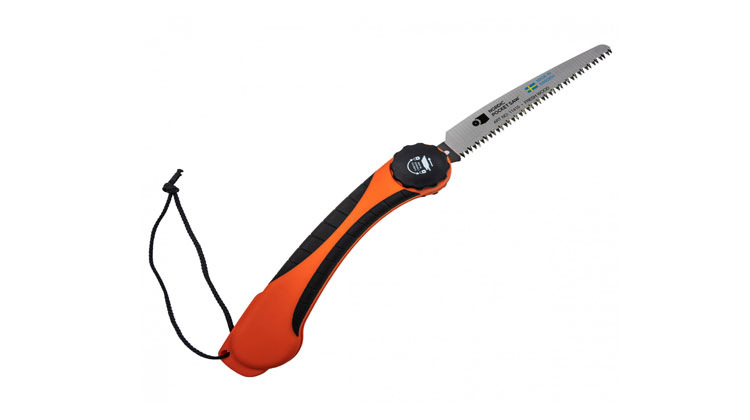
On the first step, you’ll have to tie a sufficient amount of rope to reach the tree branch you want to prune. You can take a 100 feet rope and cut it in the middle to get two equal sizes. However, you have to measure the tree height first to get the right measurement of the rope. As you have to take about double the amount of the height to make it work. You can use a pocket knife or a lighter to cut the rope.
The second step is warming up. You might not be able to throw the rope at once over the tree branch. So, you may need to warm up your shoulders and throw a few times over the branch until you can do it. But before throwing the rope, do not forget to tie the weight on one side of the rope to get a balance when throwing the rope, and so that it becomes easier to do so. Throw it on the branch you want to take down as close as possible to the trunk.
Now put on the gloves. The tricky part is getting the saw teeth down on the tree branch. If you’re lucky you will get it as wise. But in case it is facing the other way, pull back the rope and pull it from the other end. Keep doing it until you get the right way. It may take time and test your patience!
Now start sawing and maintain a steady speed. Let the saw teeth do the work without putting too much pressure on the ropes by pulling it fast. Keep sawing until you reach the end. Use your shoulder muscles or take help from a muscly person to get the job done. When you hear a crack and you’ve reached close to the end of the branch, be prepared to run.
Caution
**Do not rush or pull the rope too hard as it might tear.
**as we’re cutting bigger tree branches, the fall of the branch will be faster than you can imagine and will take a bigger space to fall. So be cautious about that and keep the children and the pets away to avoid safety risks. Also, you need to figure out beforehand where to run when the branch falls and how much distance you should maintain.
**If throwing the rope over the branch seems tricky, be tactful using a kite string attached to a rock. Throw it over the branch you want to bring down. Then you can tie the rope to it and then pull the rope over the branch. You need to tie the chainsaw with the rope in the first place in this case.
**You can also use a bow and arrow or a slingshot to send the rope over the tree branch.
If the branch you’re cutting is larger than 1.5 to 2 inches you need to use a pole saw. Oftentimes you may get a pole saw added with the pole pruner. However, there are pole saws with battery or electrically powered chainsaws that have a switch or trigger on the end for convenient on/off. You’ll get a power button on the tool for easy use.
Gears you may need:
- A Pole Saw (Manual or Powered)
Consider a few things-
Usually, we use pole saws to cut wider branches that we can not cut with the pole pruners. If the banch is large, make a few small cuts. Each cut should be a foot or a foot and a half long.
Additionally, when you try to cut the middle or end of the branch, the branch moves as you go. So, this tool is better to use on the trunk and for wider diameter of tree branches.
When cutting a branch with the pole saw, try to make more cuts than a single cut. Cut a foot of the branch from the finish cut so that the large branch doesn’t break or ruin the other branches when falling off. Yes, it does require a bit more effort, but that way the tree will be saved.
Method with a Manual Pole Saw
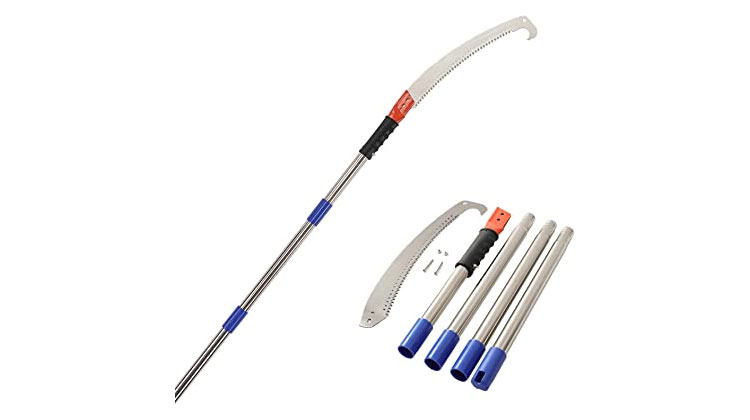
Some pole saws are electrically powered, though we are discussing how to use the manual one. As most pole pruners have a pole saw attached on the head, it comes very convenient when cutting a wider limb of the tree. Manual pole saw is a bit tricky to use on the high branches because as you give strokes, the pole flexes and absorbs some of the strengths.
Determine the place where you want to make the cut. Then give little strokes. Slowly pull the pole to make the cut. Steadily make a faster move to cut it off the branch. Ending the cut with a faster move will reduce the amount of tree bark coming off with the branch.
Consider giving the branch an undercut. However challenging with a long pole, this might also help to reduce the bark peeling off with the branch.
With a Electrically or Battery-powered Pole Saw
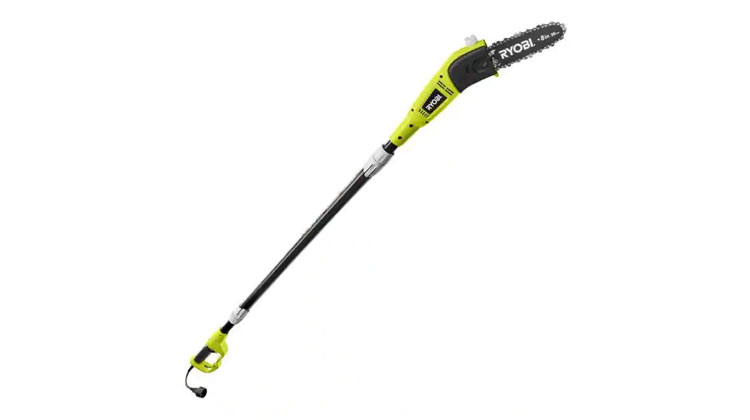
The power tool is a handy option when it comes to cutting branches from the ground. The powered pole saw might take the power from batteries, or it might run with gas or electrically powered. The tool has a chainsaw with a length of 6 to 12 inches attached to its head. The tool may have a fixed pole or it may be telescopic with a length of about 12 to 18 feet.
The cutting process is similar to a manual pole saw. But making an undercut might be difficult with a manual pole saw, not with a powered tool. With the power tool the cutting process becomes way faster and with less effort.
Caution
Be careful of the fact that, using the pole saw you’re cutting a bigger limb of the tree. So the branch will have a great speed to fall to the ground, and you need to predetermine the space where it can fall, and be at a safe place. You also need to consider the heavy tool you’re carrying.
Also when cutting the branch with a pole saw try to do that in sections.
Other Safety Gears You May Need

- Eye Protector (Safety Goggles or Face Shield)
To keep your eyes safe from the splitting wood pieces get a pair of safety goggles on your eyes. As you are standing on the ground and looking up, tiny pieces of wood or sawdust might get into your eyes from above.
- Gloves
Wear gloves to avoid sharp things from pricking. It is also useful when handling sharp objects.
- Hard Hat/ Helmet
As you’re working on the ground anything might come onto you. It could be the dead tree branches or the tool you’re using. So, it’s better to be prepared wearing a hard hat or helmet to avoid any unprepared occurrences. A 30 or 50 feet falling tool can leave a deep mark or even sirious injury.
Other Things to Consider
- When dealing with a broken branch, be extra cautious as it might fall anytime and anywhere.
- When electric cables are around take additional preparations wearing rubber gloves. However, if it seems risky, call the professionals even if it costs you a few bucks!
- If there’s a possibility that the branch might harm surrounding structures, cut it in smaller sections so that the heavy object falls and ruins the structure.
- When the size of the job is huge, don’t take it on your shoulder, rather let it handle the professionals.
Conclusion
Here we’ve described 4 different methods of cutting high branches from ground. Therefore, you pick one method that is suitable for you. And do not rush when working with sharp tools. Also, be careful about the falling branches. And don’t forget to put on the safety gears in the first place, instead of weeping later. Now, I think you have a clear idea about – How to Cut High Branches From Ground.

